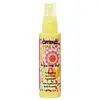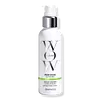What's inside
What's inside
 Key Ingredients
Key Ingredients

No key ingredients
 Benefits
Benefits

 Concerns
Concerns

 Ingredients Side-by-side
Ingredients Side-by-side

Water
Skin ConditioningButylene Glycol
HumectantIsododecane
EmollientDipropylene Glycol
HumectantAmodimethicone
Polyquaternium-37
Polysilicone-29
Silicone Quaternium-18
EmollientHippophae Rhamnoides Fruit/Seed Oil
AntimicrobialCocos Nucifera Oil
MaskingGlycolic Acid
BufferingLactic Acid
BufferingPanthenol
Skin ConditioningTocopherol
AntioxidantAloe Barbadensis Leaf Juice
Skin ConditioningTrehalose
HumectantEthyl Linoleate
EmollientEthyl Oleate
EmollientCaprylic Acid
CleansingXylitol
HumectantCetearyl Alcohol
EmollientPhenyl Trimethicone
Skin ConditioningBehentrimonium Chloride
PreservativePropylene Glycol Dicaprylate/Dicaprate
EmollientPPG-1 Trideceth-6
Skin ConditioningTrideceth-6
EmulsifyingTrideceth-12
EmulsifyingPolyglyceryl-10 Laurate
Skin ConditioningSodium Lignosulfonate
Tetrasodium Glutamate Diacetate
Maltodextrin
AbsorbentCeresin
Emulsion StabilisingMagnesium Aluminum Silicate
AbsorbentBenzyl Alcohol
PerfumingCitric Acid
BufferingPhenoxyethanol
PreservativeEthylhexylglycerin
Skin ConditioningParfum
MaskingBenzyl Benzoate
AntimicrobialHydroxycitronellal
PerfumingLimonene
PerfumingCitronellol
PerfumingCoumarin
PerfumingWater, Butylene Glycol, Isododecane, Dipropylene Glycol, Amodimethicone, Polyquaternium-37, Polysilicone-29, Silicone Quaternium-18, Hippophae Rhamnoides Fruit/Seed Oil, Cocos Nucifera Oil, Glycolic Acid, Lactic Acid, Panthenol, Tocopherol, Aloe Barbadensis Leaf Juice, Trehalose, Ethyl Linoleate, Ethyl Oleate, Caprylic Acid, Xylitol, Cetearyl Alcohol, Phenyl Trimethicone, Behentrimonium Chloride, Propylene Glycol Dicaprylate/Dicaprate, PPG-1 Trideceth-6, Trideceth-6, Trideceth-12, Polyglyceryl-10 Laurate, Sodium Lignosulfonate, Tetrasodium Glutamate Diacetate, Maltodextrin, Ceresin, Magnesium Aluminum Silicate, Benzyl Alcohol, Citric Acid, Phenoxyethanol, Ethylhexylglycerin, Parfum, Benzyl Benzoate, Hydroxycitronellal, Limonene, Citronellol, Coumarin
Water
Skin ConditioningBehentrimonium Methosulfate
Cetyl Alcohol
EmollientCaprylic/Capric Triglyceride
MaskingPolyquaternium-37
Glycerin
HumectantButylene Glycol
HumectantPhenoxyethanol
PreservativeSilicone Quaternium-18
EmollientPropylene Glycol Dicaprylate/Dicaprate
EmollientCaprylyl Glycol
EmollientCeteareth-20
CleansingPPG-26-Buteth-26
Skin ConditioningPEG-40 Hydrogenated Castor Oil
EmulsifyingParfum
MaskingTrideceth-6
EmulsifyingPPG-1 Trideceth-6
Skin ConditioningTrideceth-12
EmulsifyingCrambe Maritima Leaf Extract
Skin ConditioningAscophyllum Nodosum Extract
Skin ConditioningBenzyl Salicylate
PerfumingLinalool
PerfumingLimonene
PerfumingWater, Behentrimonium Methosulfate, Cetyl Alcohol, Caprylic/Capric Triglyceride, Polyquaternium-37, Glycerin, Butylene Glycol, Phenoxyethanol, Silicone Quaternium-18, Propylene Glycol Dicaprylate/Dicaprate, Caprylyl Glycol, Ceteareth-20, PPG-26-Buteth-26, PEG-40 Hydrogenated Castor Oil, Parfum, Trideceth-6, PPG-1 Trideceth-6, Trideceth-12, Crambe Maritima Leaf Extract, Ascophyllum Nodosum Extract, Benzyl Salicylate, Linalool, Limonene
 Reviews
Reviews

Ingredients Explained
These ingredients are found in both products.
Ingredients higher up in an ingredient list are typically present in a larger amount.
Butylene Glycol (or BG) is used within cosmetic products for a few different reasons:
Overall, Butylene Glycol is a safe and well-rounded ingredient that works well with other ingredients.
Though this ingredient works well with most skin types, some people with sensitive skin may experience a reaction such as allergic rashes, closed comedones, or itchiness.
Learn more about Butylene GlycolLimonene is a fragrance that adds scent and taste to a formulation.
It's found in the peel oil of citrus fruits and other plants such as lavender and eucalyptus. The scent of limonene is generally described as "sweet citrus".
Limonene acts as an antioxidant, meaning it helps neutralize free radicals.
When exposed to air, oxidized limonene may sensitize the skin. Because of this, limonene is often avoided by people with sensitive skin.
The term 'fragrance' is not regulated in many countries. In many cases, it is up to the brand to define this term. For instance, many brands choose to label themselves as "fragrance-free" because they are not using synthetic fragrances. However, their products may still contain ingredients such as essential oils that are considered a fragrance.
Learn more about LimoneneParfum is a catch-all term for an ingredient or more that is used to give a scent to products.
Also called "fragrance", this ingredient can be a blend of hundreds of chemicals or plant oils. This means every product with "fragrance" or "parfum" in the ingredients list is a different mixture.
For instance, Habanolide is a proprietary trade name for a specific aroma chemical. When used as a fragrance ingredient in cosmetics, most aroma chemicals fall under the broad labeling category of “FRAGRANCE” or “PARFUM” according to EU and US regulations.
The term 'parfum' or 'fragrance' is not regulated in many countries. In many cases, it is up to the brand to define this term.
For instance, many brands choose to label themselves as "fragrance-free" because they are not using synthetic fragrances. However, their products may still contain ingredients such as essential oils that are considered a fragrance by INCI standards.
One example is Calendula flower extract. Calendula is an essential oil that still imparts a scent or 'fragrance'.
Depending on the blend, the ingredients in the mixture can cause allergies and sensitivities on the skin. Some ingredients that are known EU allergens include linalool and citronellol.
Parfum can also be used to mask or cover an unpleasant scent.
The bottom line is: not all fragrances/parfum/ingredients are created equally. If you are worried about fragrances, we recommend taking a closer look at an ingredient. And of course, we always recommend speaking with a professional.
Learn more about ParfumPhenoxyethanol is a preservative that has germicide, antimicrobial, and aromatic properties. Studies show that phenoxyethanol can prevent microbial growth. By itself, it has a scent that is similar to that of a rose.
It's often used in formulations along with Caprylyl Glycol to preserve the shelf life of products.
We don't have a description for Polyquaternium-37 yet.
We don't have a description for PPG-1 Trideceth-6 yet.
Propylene Glycol Dicaprylate/Dicaprate is a mixture of Propylene Glycol Dicaprylate and Propylene Glycol Dicaprate.
It is an emollient and helps hydate the skin.
Silicone Quaternium-18 is a type of silicone.
We don't have a description for Trideceth-12 yet.
We don't have a description for Trideceth-6 yet.
Water. It's the most common cosmetic ingredient of all. You'll usually see it at the top of ingredient lists, meaning that it makes up the largest part of the product.
So why is it so popular? Water most often acts as a solvent - this means that it helps dissolve other ingredients into the formulation.
You'll also recognize water as that liquid we all need to stay alive. If you see this, drink a glass of water. Stay hydrated!
Learn more about Water